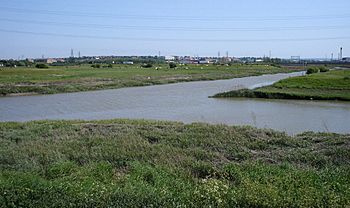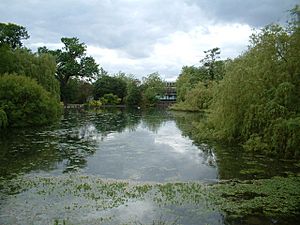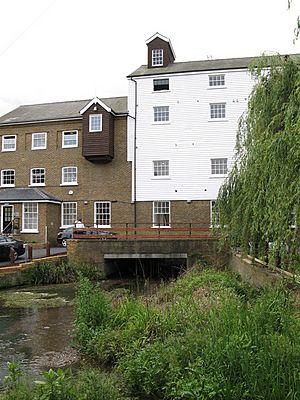River Cray facts for kids
Quick facts for kids River Cray |
|
|---|---|

Where the River Darent and the River Cray meet on Crayford Marshes.
|
|
| Physical characteristics | |
| Main source | Orpington Pond TQ 467 668 54 m (177 ft) 51°22′51″N 0°06′24″E / 51.3809°N 0.1067°E |
| River mouth | River Darent TQ 536 760 2 m (6 ft 7 in) 51°27′43″N 0°12′38″E / 51.4619°N 0.2105°E |
| Length | 9 miles (14 km) |

The River Cray is the biggest river that flows into the River Darent. It's the main river in outer, south-east Greater London. It starts in Priory Gardens, Orpington, where rainwater soaks through the chalk rock of the Downs. This water forms a pond where the ground changes from chalk to clay.
The river flows north through different areas. It passes industrial and residential St Mary Cray, then St Paul's Cray (where it used to power a paper mill). Next, it goes through Foots Cray and enters the beautiful Foots Cray Meadows parkland. Here, it flows under the Five Arches bridge, which was built in 1781. The river then continues through North Cray and Bexley. It flows past a restored Gothic-style cold plunge bath house, built around 1766.
Later, the River Shuttle, a small stream, joins the Cray. The river then flows through the parkland of Hall Place, a historic house built in 1540. The Cray turns east through Crayford and Barnes Cray to meet the Darent in Dartford Creek. This Creek is a watery area that is partly affected by tides. The villages along the River Cray are often called "The Crays."
Contents
- About the River Cray
- Places Along the River
- Watermills of the River Cray
- Orpington Mill
- Snelling's Mill, St Mary Cray
- Upper Paper Mill, St Mary Cray
- Joynson's Mill, St Mary Cray
- St Paul's Cray Mill
- Foots Cray (Nash's) Paper Mill
- Foot's Cray Mill
- Old Mill, Bexley
- Hall Place Mill, Bexley
- Swaisland's Printing Works, Crayford
- Calico Mill
- Lower (Iron) Mill, Crayford
- Crayford Saw Mill
- Crayford Flour Mills
- See also
About the River Cray
Groups like the Cray Anglers Conservation Group help keep the non-tidal parts of the river clean. They also encourage responsible angling, which means fishing in a way that protects the fish and their home. The Dartford and Crayford Restoration Trust looks after the tidal parts of the river. They also help maintain the riverbanks.
There's a special walking path called the Cray Riverway that goes along the river. It starts at Foots Cray Meadows and goes for about 10 miles (16 km) north towards the River Thames. This path is part of the London LOOP, a long walking route around London. The River Cray is also a very important place for nature, known as a Site of Metropolitan Importance for Nature Conservation. This means it's a special area where many plants and animals live.
Places Along the River
Here are some of the towns and important places you'll find along the River Cray, from south to north:
- Orpington
- St Mary Cray
- St Paul's Cray
- A20 road
- Foots Cray
- Bexley village
- A2 road
- Crayford
Watermills of the River Cray
The River Cray was once a busy place with fourteen watermills! These mills used the power of the flowing water to do different jobs. Let's look at some of them, starting from where the river begins.
Orpington Mill
This mill was mentioned in the Domesday Book, a very old survey from 1086. It was almost at the very start of the River Cray. The mill building was from the 1700s. It had a large waterwheel that was about 11 ft 6 in (3.51 m) tall. This wheel powered three pairs of millstones, which were used to grind grain.
Around the 1870s, the miller, John Colgate, added a steam engine. People called its tall chimney "Colgate's Folly" because it didn't work as well as he hoped! The mill was used as a storage place before it was taken down in 1934 or 1935.
Snelling's Mill, St Mary Cray
This was another mill mentioned in the Domesday Book. It was taken down in 1872 to make space for a public park. A large cast iron waterwheel from this mill was used to pump water for fountains at a place called "The Rookery." Sadly, the wheel was damaged by vandals and removed by 1964.
Upper Paper Mill, St Mary Cray
This mill was a paper mill. It had a waterwheel that used the water flowing underneath it. People like Nicholas Townsend and William Sims worked here in the 1700s. Martha Lay was making paper here in the early 1800s, and paper from her mill even had her name, "Martha Lay 1804," as a watermark. The mill stopped working in 1834.
Joynson's Mill, St Mary Cray
This mill started as a corn mill (for grinding grain) near St Mary Cray church. It later became a paper mill. William Joynson took over in 1834. His paper was known for its high quality, with watermarks like "Joynson Superfine." In 1839, he even got a patent for a new way to add watermarks to machine-made paper.
The mill grew very big, employing about 700 people by 1881. It made only high-quality writing papers. In 1914, paper from Joynson's mill was used to make the first £1 and 10/- banknotes issued by the Bank of England!
The mill was taken over by Wiggins Teape & Co. in 1930 and rebuilt. It then made special papers like greaseproof paper. For a while, it was even home to the National Paper Museum. The mill closed in 1967, and the museum's collection moved to the Museum of Science and Industry in Manchester.
St Paul's Cray Mill
In 1718, this mill had two waterwheels that helped prepare leather and a third for grinding corn. Later, it was replaced by a paper mill that used a turbine for power.
Foots Cray (Nash's) Paper Mill
This was another paper mill that took the place of an older corn mill. Papermaking was happening here by 1742. A steam engine was added around 1820 to help power the mill. The Nash family owned and ran the mill for many years. By 1954, it was a large factory complex, but it was taken down by 1986.
Foot's Cray Mill
This mill was also a paper mill. In the 1870s, it changed to a fabric printing works. By 1900, it was making photographic film, and its last job was processing silk. The mill had two large waterwheels, each about 15 feet (4.57 m) across. It was taken down in 1929.
Old Mill, Bexley
This mill was also mentioned in the Domesday Book. It was a corn mill. The last building on the site was from 1779. It had a waterwheel that powered four pairs of millstones. The Cannon family owned it for a long time, from 1839 to 1907.
A steam engine was put in in 1884, and a tall chimney was built. The mill was later used for making sacks. The mill burned down on May 12, 1966. Today, a pub called the Old Mill PH, with a mill theme, stands in its place. In 2007, the pub was turned into apartments.
Hall Place Mill, Bexley
This was another Domesday mill, located behind the big Hall Place mansion. It was a corn mill until 1882, when it was changed into a factory for printing silk and making flags. It was taken down in 1925. Some of its main wooden beams were even sold to an American millionaire who used them to build his mansion!
Swaisland's Printing Works, Crayford
Charles Swaisland started a printing works here in 1812. It used waterwheels to power wooden drums for washing fabric. One waterwheel was removed around 1948.
Calico Mill
This mill was located where Watling Street crossed the River Cray. In the 1700s, it was used to process calico, a type of cotton fabric.
Lower (Iron) Mill, Crayford
This mill was built in the 1500s and was used for plating metal. It was known as Crayford Iron Mill in 1800 and had a waterwheel. In 1817, it was replaced by Crayford Flour Mills.
Crayford Saw Mill
This was a saw mill that used a waterwheel to cut timber. It worked alongside the Crayford Iron Mill from 1765. Did you know that the timber for the floor of Buckingham Palace was cut here? The saw mill was still standing in 1854.
Crayford Flour Mills
The Crayford Flour Mills were built in 1817. They had a huge cast iron waterwheel, about 28 feet (8.53 m) tall, that powered five pairs of millstones for grinding flour. In 1914, the waterwheel and old machinery were removed and replaced with modern roller milling machines powered by gas engines.
See also
 In Spanish: Río Cray para niños
In Spanish: Río Cray para niños



